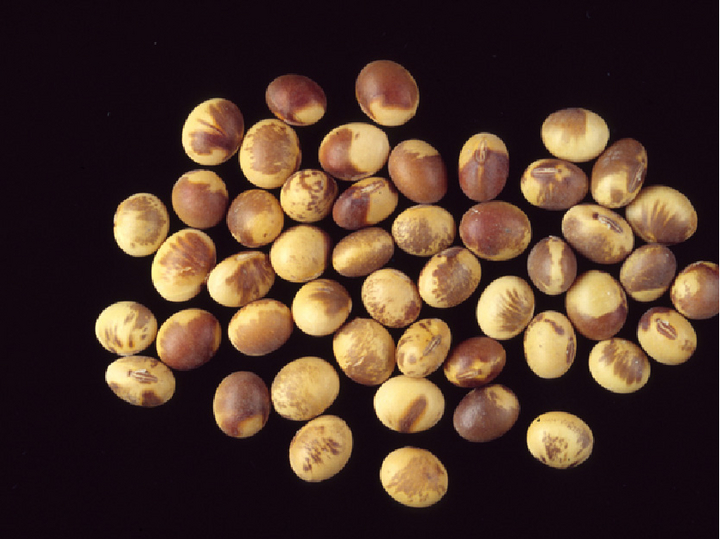Soy bean mosaic virus
Soy bean mosaic virus
Damage symptoms

Depending on the soybean variety, the virus strain, the plant age at the time of infection and the environmental conditions, an infestation manifests itself as different disease symptoms. In very susceptible varieties, young leaves show first symptoms about six to 14 days after infection as yellowish lightening of the leaf veins. After that, the following more or less distinct symptoms of the infestation become visible:
Leaves: these remain relatively small and the shoot axes between two leaf nodes (internodes) are shortened. Depending on the weather, different subsequent symptoms appear:
- Cool weather: conspicuous curling and downward bending leaf margins in conjunction with conspicuous light- to dark-green mosaic spotting of the leaf surface (leaf blades).
- Warm weather: symptoms are masked, leaves appear normal but feel leathery and brittle
Pods: plants affected by soybean mosaic virus produce significantly fewer pods, and more or less rounded to irregular brown spots with light-colored edges are found on the emerging pods. In this case, the pods are generally rather pale, flat, hairless and contain few to no seeds.
Seeds: Late ripening usually occurs, with the seeds showing distinctive brownish to black spots in the process. However, this spotting of the seeds does not always mean that virus infections are present, since seeds of an infected plant largely do not show spotting either. Therefore, they are not necessarily an indicator of an infestation by SMV, but can also be caused by other stress situations. Infected seeds often do not germinate or germinate very poorly.
Host plants
The main host plant of soybean mosaic virus is soybean(Glycine max). However, in addition to soybean, many other legumes (Fabaceae) are also affected by SMV, including:
- Indigofera hirsuta
- Helmeted bean(Lablab purpureus)
- White lupin(Lupinus albus) and yellow lupin(Lupinus luteus)
- Common bean(Phaseolus vulgaris)
- Pea(Pisum sativum)
- Fenugreek(Trigonella foenum-graecum)
- Field bean(Vicia faba) and many more.
Plants from the goosefoot family (Chenopodiaceae; e.g., quinoa, white goosefoot), passionflower family (Passifloraceae; e.g., passion fruit), brownroot family (Scrophulariaceae; e.g., large snapdragon), and nightshade family (Solanaceae; e.g., Virginia tobacco, poisonberry, garden petunia) are also host plants of this virus.
Propagation and transmission
The virus can persist on perennial weeds. It is transmitted with the seed and by aphids . The transmission is nonpersistent.
Economic importance
Most soybean varieties are susceptible to SMV, although to varying degrees in terms of the degree of infestation in the field and the formation of seed spots. Infestation can lead to significant yield losses as well as quality reductions. In the literature, average yield losses between 8 and 35 % are described, in some cases even losses of up to 94 % are reported.
Prevention and control
- Use virus-free seed for cultivation
- Cultivation as early as possible and favorable cultural measures can help to reduce infestation on young plants
- Control vectors(aphids) at an early stage
- Isolate fields with seed propagation
- Clean up virus-infected plants as early as the 2- to 4-leaf stage
Last updated: 06.09.2022
automatically translated